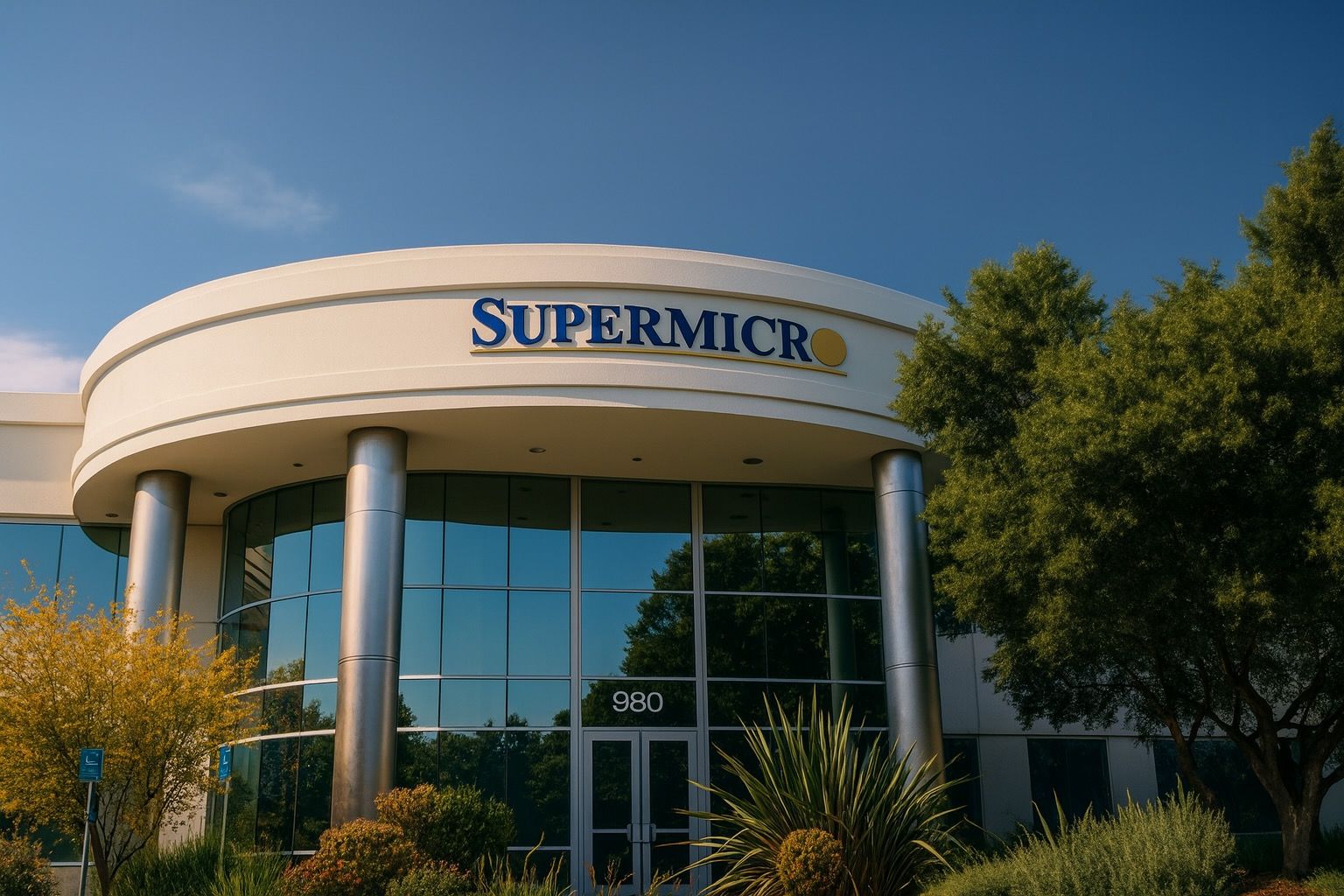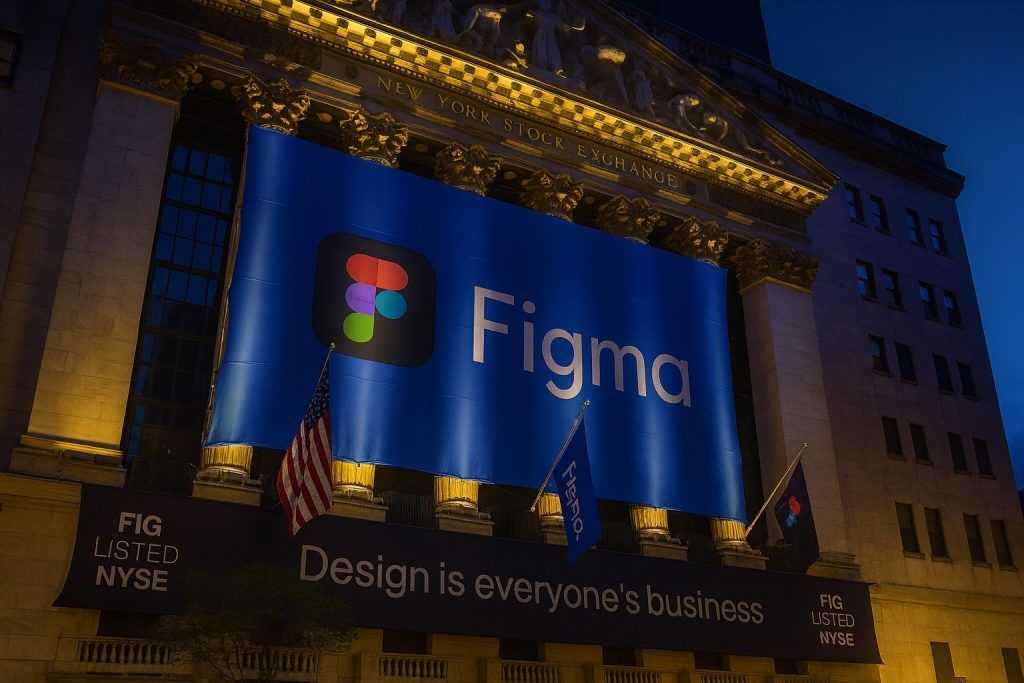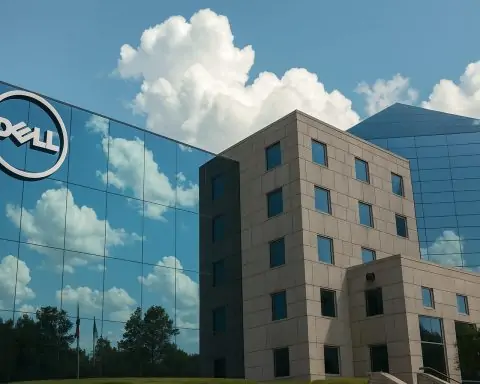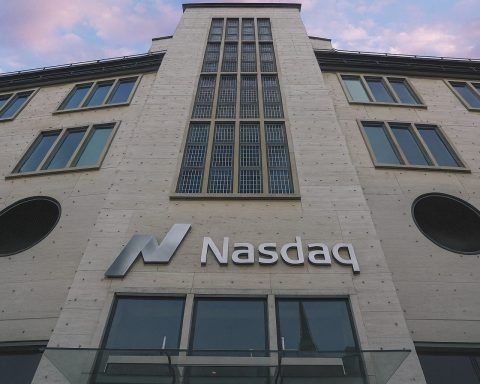- Soaring Stock in Early October: Supermicro (NASDAQ: SMCI) shares have rallied sharply in early October 2025, climbing from around $48 at the end of September to the mid-$50s by October 6 [1]. The stock jumped nearly +10% on October 1 alone (to ~$52.39) amid heavy trading volume [2], and is up ~79% year-to-date – far outpacing the Nasdaq 100’s ~19% gain [3].
- AMD-OpenAI Deal Spurs Optimism: A blockbuster AI chip deal between AMD and OpenAI announced on Oct 6 sent AMD’s stock +33% higher, and lifted Supermicro by about +6% that day to ~$55 [4]. As a key AMD server partner, Supermicro’s CFO Jean Hu said this partnership could generate “billions” in future revenue and be “highly accretive” to earnings [5].
- New AI Server Launches: Supermicro unveiled new AI-optimized servers (with advanced liquid-cooling and modular designs) at its late-September INNOVATE! 2025 event in Madrid [6]. The company highlighted close collaborations with NVIDIA, AMD, and Intel on next-gen data center systems, expanding its engineering and production footprint in EMEA to meet surging AI demand [7].
- Financial Firepower & Challenges: Fiscal 2025 revenue surged to $22 billion (nearly triple 2023 levels) with $1.0 billion net income [8]. Yet Q4 FY2025 sales of $5.8 B missed estimates, and gross margins slipped to 9.5% [9]. Management trimmed the FY2026 revenue outlook to ≥$33 B (from a $40 B prior target) [10], citing tariff costs and cooling hyperscale orders. Q1 FY2026 guidance is $6–7 B revenue with $0.40–0.52 EPS [11], and analysts forecast about $1.86 EPS for the full year [12] (down ~37% from a year ago).
- Analyst Sentiment Mixed: Wall Street has turned more cautious on SMCI. The consensus rating is now neutral (“Hold”) with average price targets in the mid-$40s – slightly below the current price [13]. Bulls like Needham see upside (target ~$60) given AI tailwinds [14], but others are bearish: Goldman Sachs, for example, slashed its target to $27 amid margin concerns [15]. Several banks cut estimates after the recent earnings miss, warning of intensifying competition and cost pressures [16].
- Competitive & Market Context: Supermicro faces giant rivals in the AI server arena. Dell ( ~$96 B FY2025 revenue) and HPE are beefing up their data-center businesses, with Dell’s servers & networking sales jumping +37% and HPE’s compute and networking segments up strongly this year [17] [18]. These deep-pocketed competitors can bundle full solutions and have longstanding enterprise relationships. “Some customers may prefer larger vendors like Dell and HPE,” notes D.A. Davidson analyst Gil Luria, warning Supermicro could lose deals to these incumbents [19]. At the same time, Supermicro’s close partnership with NVIDIA (whose AI chips are in fierce demand) gives it an edge – CEO Charles Liang boasts his company has the “best track record of fast and successful deployments of new NVIDIA technologies” in data centers [20].
- AI Infrastructure Boom (Big Opportunity, Big Risks): Industry-wide, demand for AI servers is skyrocketing. Global data-center investment is expected to top $170 B in 2025, and the overall market could reach $527 B by 2025 thanks to cloud and AI/ML expansion [21]. Cutting-edge AI workloads consume vastly more power (NVIDIA’s latest GPU farms draw ~3× the power of previous gen), pushing operators toward hybrid liquid coolingto handle dense racks [22]. This plays to Supermicro’s strengths in high-density, liquid-cooled systems. However, it also highlights challenges: power constraints, supply-chain bottlenecks, and export restrictions (e.g. on high-end chips to China) that could limit sales. Susquehanna’s Mehdi Hosseini cautions that Supermicro’s shrinking margins and rising expenses signal “rising competition”, and he sees limited upside unless the company can stabilize profitability [23].
Stock Price Performance (Early October 2025)
Supermicro’s stock has been on a rollercoaster in 2025, and early October saw another upswing. On October 1, SMCI shares surged ~9–10% in one day (closing at $52.39 [24]) after breaking above a key moving average, accompanied by unusually high volume of ~45–48 million shares traded [25] [26]. This rebound came after a late-September dip and signaled renewed investor interest in the company’s AI server story. By October 6, the stock continued climbing to around $55 (a ~15% gain from late September) [27], before settling in the mid-$50s on October 7. Year-to-date, SMCI has returned roughly +79% – a remarkable run that dwarfs the Nasdaq-100’s ~19% gain in the same period [28]. This momentum reflects the market’s enthusiasm for AI-centric tech plays, though it’s also a volatileride (SMCI’s beta is ~2.7, indicating much higher swings than the market average [29]).
What’s driving the latest move? A big catalyst came on Oct 6, when AMD announced a landmark partnership with OpenAI to supply next-gen AI chips. That news sent AMD’s stock soaring +33% in one day and lifted sympathy plays across the AI hardware ecosystem – including Supermicro [30]. As a close OEM partner that integrates AMD’s CPUs/GPUs into its servers, Supermicro saw its shares jump about +6% on the day to ~$55 [31]. Investors are essentially betting that OpenAI’s massive hardware spend (the deal is to deploy 6 gigawatts of AMD Instinct GPU power) will trickle down to server manufacturers like Supermicro. Supermicro’s CFO Jean Hu underscored the opportunity, saying this multi-year AMD collaboration could ultimately generate “billions” in revenue for the company and be “highly accretive” to earnings [32]. It’s a vote of confidence that Supermicro can capture a chunk of the AI gold rush as big cloud players race to build out infrastructure.
It’s worth noting that SMCI’s recent price of ~$56–57 (Oct 7) is still below its 52-week peak (around $66, post-split) and well above its lows (~$17) [33]. The stock underwent a 10-for-1 split in late 2024 [34] after a spectacular 2022–2023 surge, and then experienced sharp corrections when results disappointed. This history of boom-bust swings means investors should expect continued volatility. As Bokeh Capital’s Kim Forrest observed, expectations for AI winners are so elevated that even minor hiccups can trigger outsized drops – “any softness in results triggers large stock declines” [35]. Supermicro’s recent bounce shows the upside of that dynamic; the challenge will be maintaining momentum through the next set of earnings and beyond.
Recent News & Catalysts (Product Launches, Partnerships, Executive Insights)
In addition to market-wide AI excitement, Supermicro has delivered company-specific news fueling interest:
- New AI-Optimized Servers (Madrid Event): In late September, Supermicro held its INNOVATE! Europe 2025event in Madrid, unveiling a lineup of cutting-edge servers tailored for AI and high-performance computing. These new systems emphasize liquid cooling and modular “building block” designs to enable rapid deployment of AI data centers [36]. The company showcased how its platforms incorporate the latest NVIDIA, AMD, and Intel chips – highlighting partnerships with all three semiconductor giants [37]. This European launch is part of Supermicro’s push to expand in EMEA (Europe, Middle East, Africa) with new engineering and production facilities, aiming to better serve global cloud and enterprise customers. Analysts noted that while the product announcements reinforce Supermicro’s positioning at the heart of the AI boom, the real near-term growth driverwill be landing large-scale orders for these new systems [38]. Still, the focus on energy-efficient, liquid-cooled designs is timely: data centers are grappling with power density issues, and Supermicro is trying to differentiate itself as a leader in cooling and fast deployments.
- Major AI Deals – AMD & NVIDIA: As mentioned, AMD’s OpenAI deal on Oct 6 was a big external catalyst. Supermicro, being an official OEM partner for AMD, stands to benefit as OpenAI (and potentially others) roll out new GPU clusters using AMD chips. Importantly, this comes on the heels of NVIDIA’s own megadeal: last month Nvidia revealed a $100 billion partnership with OpenAI to provide 10 gigawatts of its new “Vera Rubin” AI systems [39]. While those GPU deals are between chipmakers and OpenAI, Supermicro often plays the role of systems integrator – building the server racks and nodes that house these chips. In fact, Supermicro was among the first to ship servers based on NVIDIA’s latest Blackwell GPU architecture, beating some larger rivals to market [40]. CEO Charles Liang has proudly noted that Supermicro has the industry’s “best track record for fast and successful deployments” of NVIDIA’s newest AI platforms [41]. This agility has made Supermicro a go-to vendor when cloud firms and research labs want the absolute latest in AI hardware, a reputation that underpins its growth story.
- Strategic Partnerships & Projects: Supermicro is also teaming up on turnkey data center solutions. For example, it partnered with a startup (DigiPowerX’s US Data Centers division) on a Tier-3 modular data center design that can pack up to 256 NVIDIA GPUs per pod – an incredibly dense configuration [42] [43]. The first 40 MW deployment in Alabama is slated for Q4 2025, and Supermicro won the server order to supply those GPU systems [44]. Projects like this showcase Supermicro’s role in the broader AI infrastructure ecosystem: not just selling individual servers, but providing whole racks and data center modules optimized for AI workloads. It’s a competitive advantage for niche, high-density projects, though scaling such bespoke solutions will require capital and flawless execution.
- Financial Statement & Audit Update: One lingering corporate issue has been regulatory scrutiny of Supermicro’s internal controls. In late 2024 the company’s independent auditor resigned, causing delays in financial filings and drawing attention from the SEC [45]. Supermicro had to tighten its accounting oversight, which it says is now on track. The episode forced management to be more conservative – they cited “audit and compliance costs” as one reason for delaying some orders and trimming the revenue forecast [46]. While largely in the rearview now, this serves as a reminder that Supermicro, a once-obscure mid-cap, is maturing into a much larger enterprise and facing growing pains (much like many fast-growth tech firms before it). So far, there haven’t been further red flags on this front in 2025, and the focus has returned to operations and growth.
Financial Performance and Outlook
Supermicro’s fiscal year 2025 (which ended June 30, 2025) was a tale of explosive growth tempered by recent disappointments. Headline numbers were eye-popping: $21.97 billion in revenue (up ~47% year-over-year) with net income of $1.05 billion [47]. That means sales nearly tripled from just two years ago [48], a testament to how demand for AI servers drove a huge expansion in Supermicro’s business. The company’s flexible assembly model and speed-to-market with new chips allowed it to capture the early wave of AI infrastructure spending. Cash flow has been strong as well – for instance, operating cash flow was $864 M in Q4 alone [49], giving the company liquidity to reinvest in capacity.
However, cracks started to show in the June quarter (Q4 FY2025) results: revenue of $5.76 B fell slightly below analysts’ $5.88 B estimate, and net income ($195 M, or $0.41 EPS) also missed the mark [50]. The miss was attributed to an “unfavorable product mix” – essentially, more lower-margin orders (like big hyperscale contracts) and fewer high-margin enterprise deals [51]. Gross profit margin for the quarter was 9.5%, down from 10.2% a year prior [52], squeezed by higher costs (tariffs on components and intense price competition on large deals). This combination of factors led to a 15.5% stock drop in the days after the Q4 earnings release [53] [54]. It was a harsh reminder that after a year of triple-digit percentage stock gains, investors had little tolerance for anything less than perfect performance.
In response, Supermicro’s management took a more conservative stance for the coming year. They guided FY2026 (ending June 2026) revenue to “at least $33 billion”, which is still ~50% growth over FY2025 but notably lower than a preliminary $40 B aspirational target they had floated earlier [55]. For the immediate quarter (Q1 FY2026), they expect $6–7 B sales and $0.40–0.52 non-GAAP EPS [56] – a sequential dip from Q4’s level, reflecting some order push-outs and that tariff-related cost drag persisting into the near term. Notably, CFO Hu said they are not seeing demand vanish, but timing is an issue: certain large customers delayed orders due to uncertainty around U.S.–China trade policies (some export controls were hinted at, then paused) [57] [58], and Supermicro doesn’t want to book revenue at ultra-low margin just for the sake of top-line growth.
Analysts have accordingly adjusted their models. Consensus forecasts compiled by MarketBeat project around $32.8 Brevenue for FY2026 and EPS of roughly $1.85–$1.90, which would be a ~10% increase in earnings over FY2025 [59]. In other words, Wall Street expects growth to continue, but at a more moderate pace, and with profit margins remaining slim until perhaps late 2026. The company’s high-level target of $40+ B in annual revenue is now pushed out to FY2027 or beyond [60] (when analysts see ~$40.9 B rev and ~$3.30 EPS [61] if all goes well). Supermicro itself emphasizes that AI-optimized servers will be the primary growth engine driving these numbers [62], and it’s investing heavily in capacity – from expanding U.S. factories to a new Malaysia facility – to be able to fulfill the next wave of big orders [63]. The balance sheet is reasonably strong (current ratio ~5.2, moderate debt/equity ~0.8 [64]), so they have some flexibility to fund growth internally. Importantly, unlike Dell or HPE, Supermicro doesn’t pay a dividend and hasn’t done large buybacks – it’s plowing profits back into R&D and production to seize the AI opportunity [65].
The big question: Can Supermicro sustain its edge and high growth profitably? Management argues yes – pointing to their modular design approach, quick-turn manufacturing, and deep ties with Nvidia (for GPUs) as competitive advantages [66]. They also tout a broadening product line (from GPU servers to storage systems and full racks) that can increase their share of wallet in big projects. Skeptics, however, worry that as the overall pie grows, the big incumbents (like Dell, HPE, Lenovo) will assert their dominance, potentially by undercutting prices or bundling services that Supermicro can’t match. This competitive pressure is one reason margins are under stress now, and why Supermicro’s FY2026 outlook – while robust – was dialed back.
Competition: Supermicro vs. Tech Titans (Dell, HPE, Lenovo, Nvidia)
Supermicro may be a leader in specialized AI servers, but it competes in a landscape of giants. Here’s how it stacks up and what’s happening with key peers:
- Dell Technologies (DELL): Dell is massive compared to SMCI, with FY2025 revenue of $95.6 B [67]. Dell’s Infrastructure Solutions Group (which includes servers, storage, networking) pulled in $43.6 B (+29% YoY) – roughly double Supermicro’s total sales [68]. Dell is aggressively riding the same AI wave: its servers & networking revenue grew +37% last year [69], aided by demand for AI-capable servers. Dell has been marketing AI-ready solutions (some incorporating Nvidia HGX systems), and it has the advantage of a huge global salesforce and enterprise support network. With a healthy operating margin (Dell’s diluted EPS jumped 39% in FY25 [70]) and shareholder-friendly moves like dividend increases and share buybacks [71], Dell has financial leeway to compete on price or package deals. Supermicro’s niche is moving faster and customizing more; Dell’s strength is scale and one-stop-shop appeal. It’s telling that after Supermicro’s disappointing Q4, Reuters reported Dell’s stock actually fell in sympathy [72] – implying investors see their fates as linked in the AI server market to some extent (what hurts one could hint at broader issues, and vice versa).
- Hewlett Packard Enterprise (HPE): HPE, another heavyweight, had about $28 B in revenue last year and is also growing its server business. In the latest quarter (Q3 FY25), HPE’s compute (server) sales were up +16% and its networking sales (bolstered by the Aruba acquisition) up +54% [73]. HPE is pivoting to an as-a-service model (GreenLake) which offers on-premise cloud and AI infrastructure on a consumption basis [74]. This could be a double-edged sword for Supermicro: on one hand, HPE’s focus on services might slow its hardware sales momentum; on the other, HPE’s deep ties with Fortune 500 clients mean it can bundle hardware, software, and financing in ways Supermicro (which mostly just sells boxes) cannot. HPE’s guidance for the full FY25 was ~$1.9 EPS (non-GAAP) [75], showing it runs at higher profitability per dollar of sales than Supermicro currently does. Analysts often mention HPE and Dell in the same breath as formidable rivals that could win deals at Supermicro’s expense if it stumbles on execution or support.
- Lenovo (LNVGY): Lenovo is best known for PCs, but it has a growing data center division. In its FY2024/25, Lenovo’s Infrastructure Solutions Group achieved >60% revenue growth, reaching profitability for the first time [76]. Lenovo did ~$69 B total revenue (with PCs still the majority) [77]. They are emphasizing an “AI everywhere” strategy – from edge devices to cloud. Lenovo’s global reach (especially in Asia) and its partnerships (with the likes of VMware, Nutanix, and even Nvidia for reference designs) make it another big competitor in servers. While Supermicro focuses on cutting-edge systems, Lenovo can leverage volume and end-to-end solutions (they even talk about “AI PCs” coming to market [78]). For now, Lenovo’s server market share is lower in the US, but it’s a major player internationally.
- NVIDIA (NVDA): Nvidia isn’t a direct server vendor to enterprises (it supplies GPUs to companies like Supermicro), but it’s impossible to ignore here because Nvidia’s moves can both boost and threaten Supermicro. On one hand, Nvidia’s blockbuster growth – FY2025 revenue skyrocketed +114% to $130.5 B driven by AI chip sales [79] – is the tide lifting all AI infrastructure boats. Supermicro’s fortunes are closely tied to Nvidia’s: when Nvidia’s newest GPUs (like the Blackwell generation) launch, Supermicro gets a sales bump by being first to market with servers housing them [80]. On the other hand, Nvidia has started offering more integrated systems(like DGX supercomputers and the mentioned Vera Rubin system) directly to large customers. If Nvidia (and AMD similarly) continue to move up the value chain, selling complete AI racks, it could cut into the addressable market for third-party server makers. So far, demand is so insatiable that Nvidia “sells every AI chip it can make” [81] and relies on partners to integrate them, but industry dynamics can shift if supply catches up to demand. It’s also notable that Nvidia’s market cap and R&D budget dwarf Supermicro’s – any technological leap (say, a new chip that needs special cooling) Nvidia can facilitate or even produce reference designs in-house.
In summary, Supermicro is punching above its weight in an arena with far larger players. It has carved out a strong position in the AI server niche through speed and specialization, but maintaining that lead will be an ongoing battle. As one analyst quipped, Supermicro remains a “show-me story” – it must continue proving that a relatively smaller company can keep its edge in an industry dominated by multinationals [82].
Analyst Views: Bulls vs. Bears
Despite Supermicro’s impressive growth, Wall Street’s outlook is cautious at this stage. According to MarketBeat, the stock carries a consensus “Hold” rating with an average price target around $45–47 per share [83] [84]. That’s actually a bit below the recent trading price (~$56), implying analysts on average see the stock as fully valued after its big rebound. The target range is wide, reflecting the split opinions on Supermicro’s prospects – per Nasdaq’s compilation, targets span from $27 on the low end to $60 at the high end [85].
On the bullish side, a minority of analysts argue that Supermicro’s growth is still underestimated. For example, Needham recently raised its SMCI target to $60 [86], expressing confidence that booming AI infrastructure spend will propel Supermicro’s sales higher than the conservative guidance. Bulls highlight that Supermicro is trading around ~20× forward earnings [87], which isn’t cheap in absolute terms, but they note the company is expected to nearly double earnings (from $1.68 EPS in FY25 to ~$3.30 by FY27 [88]) if it executes well. In that scenario, the valuation would quickly look more reasonable. Optimists also point to Supermicro’s strong balance sheet and cash generation as enablers for expansion, and even muse that Supermicro could be an acquisition target for a larger tech company that wants instant expertise in AI server manufacturing (though there are no concrete rumors, it’s a talking point given the strategic value of what Supermicro builds).
The bearish or skeptical analysts focus on risks. A key concern is margin pressure – Supermicro’s recent gross margin around 9–10% [89] is much thinner than most tech hardware peers. If competition forces prices down further or costs (like memory, cooling components, or labor) rise, profits could get crimped. Goldman Sachs’ extremely low $27 target came after Q4 results; Goldman basically believes Supermicro’s earnings may not ramp as hoped and that the stock, which had run up hugely, could fall back to a more modest P/E multiple on lowered earnings [90]. Bears also emphasize customer concentration and competition. Supermicro derives a large portion of revenue from a few big cloud customers (e.g., AWS, Meta, etc. as inferred from industry reports), which can be volatile – a pause in orders from just one could dent results. “Rising competition” from bigger players is the phrase you’ll see frequently, as mentioned by Susquehanna’s Hosseini [91]. Additionally, short-sellers at times have targeted SMCI, questioning whether its meteoric stock rise in 2023 was overdone. While no major fraud allegations persist (earlier concerns about component sourcing proved unfounded), the presence of shorts means any stumble might be amplified by negative momentum.
Overall, the analyst community is in a wait-and-see mode. About 3 out of 13 tracked analysts rate SMCI a “Buy”, with the majority at Hold and a couple at Sell [92]. This tempered stance underscores that Supermicro has to execute near-flawlessly to justify further stock gains. It’s not that analysts doubt the AI trend – rather, they are unsure if Supermicro can maintain its slice of that expanding pie without seeing profitability erode. The next earnings report and how the company navigates supply chain and competition in the coming quarters will be crucial to either validate the bull case or give ammunition to the bears.
The Road Ahead: AI Market Boom vs. Execution Risks
Stepping back, Supermicro finds itself at the center of a transformative moment in tech. The rise of generative AI and large-scale data center buildouts is a secular trend that could run for years. As Brightlio Research noted, cloud and AI adoption are fueling a “record pace” of data center expansion worldwide [93]. Hyperscalers (like Amazon, Microsoft, Google) are projected to dramatically increase capex for AI-specific hardware, and enterprises are following suit – all of which bodes well for companies providing the “picks and shovels” of the AI gold rush.
Supermicro’s strong points heading into this future include its agility (quickly designing and delivering customized servers for new chips), its close alliances with top chipmakers (NVIDIA’s CEO Jensen Huang gave Supermicro an early nod by allocating them new GPU supply, and AMD’s deal now ties in as well), and a proven ability to scale revenue. The company is effectively betting that it can become to AI servers what, say, Foxconn is to smartphones – a high-volume assembler with just enough value-add and IP to command some margin, while riding a much larger wave of demand.
That said, the company’s challenges are non-trivial. The industry context brings growing pains: power and cooling constraints mean simply shipping more servers isn’t enough; they need to innovate in energy efficiency (hence the liquid cooling focus). Supply chain hiccups (whether it’s getting enough GPUs or other components) can delay deliveries – a problem when customers want hardware ASAP to train AI models. Geopolitical factors loom as well: new U.S. export controls on advanced chips to China (if fully enforced) could indirectly impact Supermicro, which has a global customer base including Asia [94]. While the U.S. has paused some restrictions for now to facilitate trade talks [95], this area remains a wildcard.
For investors, Supermicro offers a high-reward but high-risk profile. The upside scenario is compelling: if AI-driven growth continues at the current clip, Supermicro could see its revenues hit the $30–40 B range in the next 1–2 years and perhaps exceed that if they grab even more market share. In that world, earnings would scale up, potentially making today’s valuation look cheap. There’s even the possibility of expanding margins if economies of scale kick in or if Supermicro moves some production to lower-cost regions and improves efficiency. Also, success could eventually lead the company to consider returning capital to shareholders (initiating dividends or buybacks) as it matures, which could broaden its appeal.
The downside or base-case scenario is that competition and execution issues keep Supermicro in a boom-bust cycle. If, for instance, Dell or HPE aggressively court Supermicro’s top customers with bundled deals, Supermicro might have to sacrifice margin (cut prices) to win orders, or worse, lose some deals outright. Larger rivals can also invest in similar modular architectures – nothing stops them from copying aspects of Supermicro’s approach, albeit more slowly. We’ve already seen that even a small earnings miss can whack the stock (-15% on Q4 miss [96]), so volatility will likely persist. Supermicro’s management, led by CEO Liang (who founded the company in 1993), will need to prove quarter after quarter that they can fend off the giants and capitalize on the seemingly insatiable demand for AI servers.
In conclusion, Supermicro today sits at the crossroads of opportunity and risk. The AI server boom could propel the company to new heights – Supermicro is unquestionably a key player enabling the AI revolution, and it’s reaping the rewards of that status in real time. Yet, the company’s recent hiccups and the increasingly crowded competitive field mean investors should keep their eyes open. As one industry report summed up, the market for AI data center hardware is “both unprecedented in scale and unforgiving in its demands” [97]. Supermicro has proven it can ride the crest of this wave, but staying on top will require deft navigation. For those bullish on the AI infrastructure theme and willing to tolerate white-knuckle volatility, SMCI remains an exciting, albeit challenging, stock to watch in late 2025 and beyond.
Sources: Key information was compiled from Supermicro’s latest financial reports, market data, and expert commentary in financial media. Notable references include Tech Space 2.0’s in-depth analyses [98] [99], Benzinga/Yahoo Finance news on the AMD–OpenAI deal [100] [101], Reuters and Simply Wall St insights on product launches and industry trends [102] [103], as well as Yahoo Finance and Bloomberg data for stock performance and forecasts [104] [105]. This report integrates those insights to provide a comprehensive, up-to-date overview of Supermicro (SMCI) as of October 7, 2025.
References
1. stockanalysis.com, 2. ts2.tech, 3. www.benzinga.com, 4. www.benzinga.com, 5. www.benzinga.com, 6. simplywall.st, 7. simplywall.st, 8. ts2.tech, 9. ts2.tech, 10. ts2.tech, 11. ts2.tech, 12. ts2.tech, 13. ts2.tech, 14. ts2.tech, 15. ts2.tech, 16. ts2.tech, 17. ts2.tech, 18. ts2.tech, 19. ts2.tech, 20. ts2.tech, 21. ts2.tech, 22. ts2.tech, 23. ts2.tech, 24. ts2.tech, 25. ts2.tech, 26. ts2.tech, 27. stockanalysis.com, 28. www.benzinga.com, 29. ts2.tech, 30. www.benzinga.com, 31. www.benzinga.com, 32. www.benzinga.com, 33. ts2.tech, 34. ts2.tech, 35. ts2.tech, 36. simplywall.st, 37. simplywall.st, 38. simplywall.st, 39. www.benzinga.com, 40. ts2.tech, 41. ts2.tech, 42. www.benzinga.com, 43. www.benzinga.com, 44. www.benzinga.com, 45. www.benzinga.com, 46. www.benzinga.com, 47. ts2.tech, 48. ts2.tech, 49. ts2.tech, 50. ts2.tech, 51. markets.traderfox.com, 52. ts2.tech, 53. ts2.tech, 54. ts2.tech, 55. ts2.tech, 56. ts2.tech, 57. www.benzinga.com, 58. www.benzinga.com, 59. ts2.tech, 60. ts2.tech, 61. ts2.tech, 62. ts2.tech, 63. ts2.tech, 64. ts2.tech, 65. ts2.tech, 66. ts2.tech, 67. ts2.tech, 68. ts2.tech, 69. ts2.tech, 70. ts2.tech, 71. ts2.tech, 72. markets.traderfox.com, 73. ts2.tech, 74. ts2.tech, 75. ts2.tech, 76. ts2.tech, 77. ts2.tech, 78. ts2.tech, 79. ts2.tech, 80. ts2.tech, 81. www.reuters.com, 82. www.benzinga.com, 83. ts2.tech, 84. ts2.tech, 85. ts2.tech, 86. ts2.tech, 87. ts2.tech, 88. ts2.tech, 89. ts2.tech, 90. ts2.tech, 91. ts2.tech, 92. ts2.tech, 93. ts2.tech, 94. ts2.tech, 95. www.benzinga.com, 96. ts2.tech, 97. ts2.tech, 98. ts2.tech, 99. ts2.tech, 100. www.benzinga.com, 101. www.benzinga.com, 102. simplywall.st, 103. www.reuters.com, 104. stockanalysis.com, 105. ts2.tech










